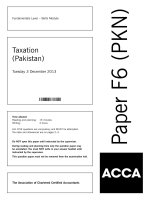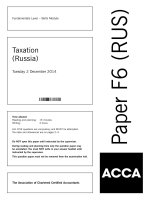ACCA f6 taxation romania 2014 dec answer
Bạn đang xem bản rút gọn của tài liệu. Xem và tải ngay bản đầy đủ của tài liệu tại đây (224.18 KB, 10 trang )
Answers
Fundamentals Level – Skills Module, Paper F6 (ROM)
Taxation (Romania)
December 2014 Answers
and Marking Scheme
Marks
1
AppleTree SRL
(a)
Taxpayers subject to corporate income tax
Taxpayers subject to corporate income tax are:
–
–
–
–
–
–
Romanian legal persons;
foreign legal persons having a permanent establishment in Romania;
foreign legal persons and individuals who have activities in Romania through a partnership;
foreign legal persons having revenues from transactions with immovable property or shares in Romania;
Romanian resident individuals in partnership with a Romanian legal person;
legal persons established according to the European legislation and having registered office in Romania.
TWO only required, 1 mark each
(b)
Prepayments of corporate income tax
Corporate income tax in 2013 = 16% x 530,000 = 84,800 lei
Quarterly prepayment of corporate income tax in 2014 = (84,800*(1 + 3·5%))/4 = 21,942 lei
The quarterly prepayment must be paid and declared by the 25th of the first month following the quarter
end, i.e. 25 April 2014, 25 July 2014, 25 October 2014 and 25 January 2015.
(c)
2
–––
1
1½
1½
–––
4
–––
Tax on dividends paid
Legal reserve = lower of 5%*net profit; and 20%*share capital
= lower of (5%*450,000; 20%*20,000) = lower of (22,500; 4,000) = 4,000 lei
1
Distributable profit = (net profit – legal reserve) = 450,000 – 4,000 = 446,000 lei
½
Gross dividends = Distributable profit = 446,000 lei
Dividends distributed to Adam SRL
Gross dividends = 60%*446,000 = 267,600 lei
½
Tax on dividends = 16%*267,600 = 42,816 lei
½
Dividends distributed to Eve Co
Gross dividends = 40%*446,000 = 178,400 lei
½
Tax on dividends = 16%*178,400 = 28,544 lei
1
–––
4
–––
15
Marks
(d)
Corporate income tax for 2014
2014
(lei)
1,200,000
(34,000)
(10,000)
(0)
(0)
(0)
(24,000)
(9,000)
257,200
7,200
9,000
70,000
0
50,000
100,000
6,000
5,000
10,000
1,414,200
226,272
(87,768)
138,504
Profit before tax
Non-taxable revenues
Reimbursed fine
Dividends from Austrian company
Loan related revenues (W1)
Insurance revenues (W2)
Bad debt provision revenues (W3)
Tax depreciation (W4)
Non-deductible expenses
Accounting depreciation (W4)
Loan related expenses (W1)
Bad debts provision expenses (W5)
Bad debt loss (W3)
Annual leave provision
Litigation provision
Voluntary pension insurance (W6)
Life insurance (1,000 lei*5)
Stolen goods expense (W2)
Taxable income for 2014
Corporate income tax for 2014 (at 16%)
Prepayments of tax (21,942*4)
Corporate income tax to be paid on settlement
WORKINGS
(W1) Loan related revenues and expenses
Exchange differences
The exchange rate difference revenues should be offset by related expenses (13,000 – 10,000 = 3,000 lei).
As the result is a gain, it will be taxed in full, so no adjustment is required.
Interest expense
Interest expense for 2014 = 200,000*8%*6/12*4·5 = 36,000 lei
Maximum interest deduction = 200,000*6%*6/12*4·5 = 27,000 lei
⇒
⇒
Non-deductible interest without the possibility to carry forward = 36,000 – 27,000 = 9,000 lei
Interest subject to debt-to-equity limitation = 27,000 lei
Debt-to-equity ratio = Average debt/Average equity = 450,000/847,000 = 0·53
Average debt = (Debt on 1 January 2014 + Debt on 31 December 2014)/2 = (0 + 200,000*4·5)/2 =
450,000 lei
Average equity = (Equity on 1 January 2014 + Equity on 31 December 2014)/2 = (470,000 +
1,224,000)/2 = 847,000 lei
Equity on 1 January 2014 = Share capital + Legal reserve + Non-distributed profit = 20,000 + 4,000 +
446,000 = 470,000 lei
Equity on 31 December 2014 = Share capital + Legal reserve + Non-distributed profit + Accounting profit
of 2014 = 20,000 + 4,000 + 0 + 1,200,000 = 1,224,000 lei
⇒
As the debt-to-equity ratio is between 0 and 3, the interest of 27,000 lei is fully deductible in
2014.
(W2) Stolen goods expenses and revenues
Insurance revenues received from the insurance company for the stolen goods are fully taxable.
Only the expenses related to the insured goods are deductible.
⇒
⇒
4,000 lei expense for the stolen car is deductible, but
10,000 lei expense for the stolen jams is non-deductible.
16
½
1
1½
½
2
1½
1
4
2
1
½
½
1
1
1
½
½
–––
20
–––
30
–––
Marks
(W3) Bad debt provision revenues and bad debt loss
2013
Registered bad debt provision expenses of 60,000 lei.
Tax deductible expenses is only 30%*120,000 = 36,000 lei
Non-deductible = (60,000 – 36,000) = 24,000
2014
Registered to revenues (released provision) of 60,000 lei.
Of which 36,000 lei (previously deducted) will be taxable and the remaining 24,000 lei non-taxable.
The loss expense of 120,000 lei is entirely deductible (Mr X died and the loss may not be covered by his
heirs).
(W4) Tax and accounting depreciation
Date of purchase: 20 June 2014
Tax depreciation period: 4 years
Monthly tax depreciation = lower of 86,400/48; and 1,500 lei
= lower of (1,800; 1,500) = 1,500 lei
Number of months of depreciation in 2014: 6 (July to December 2014)
Tax depreciation in 2014 = 1,500*6 = 9,000 lei
Date of purchase: 20 June 2014
Accounting depreciation period: 6 years
Monthly accounting depreciation = 86,400/72 = 1,200 lei
Number of months of depreciation in 2014: 6 (July to December 2014)
Accounting depreciation in 2014 = 1,200*6 = 7,200 lei
(W5) Bad debts provisions
Age of
receivable
Value of
receivable
Provision
percentage
180 days
360 days
lei
200,000
300,000
20%
40%
Value of
provision
expense
Provision
percentage
which may be
tax deducted
lei
40,000
120,000
0%
30%
Value of
provision
expense which
may be
deducted
lei
0
90,000
Non-deductible expenses re bad debt provisions = 40,000 + (120,000 – 90,000) = 70,000 lei
(W6) Voluntary pension insurance
Limit of voluntary pension deduction/year/employee = 400 euro*4·5 = 1,800 lei
Voluntary pension expense/year/employee = 3,000 lei
Non-deductible pension expense/year/employee = 1,200 lei
Number of employees = 5
Total non-deductible expenses with voluntary pension insurance = 6,000 lei
Tutorial notes:
1. The dividend received from the Austrian company is not exempt from corporate income tax because
the shareholding is less than 10%.
2. No tax allowance is given for debts due for less than 270 days.
17
Marks
2
Mr Lemon and Miss Orange
(a)
Fiscal residence conditions
An individual is considered resident for tax purposes in Romania if at least one of the conditions below is
fulfilled:
(1) has his/her domicile in Romania;
½
(2) has the centre of his/her vital interests in Romania;
½
(3) is present in Romania for one or more periods which exceed 183 days during 12 consecutive months
ending in the calendar year;
½
(4) is a Romanian citizen working abroad as a public servant or employee of Romania in a foreign country.
½
Mr Lemon fulfils condition (3) during 2014, as he will have stayed in Romania for more than 183 days.
However, he will not be considered as tax resident in Romania in 2014, as tax residency is not changed
during a year, only from the beginning of the following tax year.
(b)
1
–––
3
–––
Income tax due in Romania by Mr Lemon
Dividend revenue
Gross dividend = 100,000*10% = 10,000 lei
½
Income tax = 16%*10,000 = 1,600 lei
½
The income tax on the dividends must be withheld, paid and declared by Rogerman SRL.
½
Employment revenue
Monthly gross employment income = 3,000*4·5 = 13,500 lei
½
Monthly social contributions = 600*4·5 = 2,700 lei
½
Monthly net income = 13,500 – 2,700 = 10,800 lei
½
Monthly income tax = 16%*10,800 = 1,728 lei
½
Total income tax due in 2014 = 1,728*10 = 17,280 lei
½
Mr Lemon has the obligation to pay and declare the income tax for the employment income, unless he agrees
otherwise with his employer, in writing.
(c)
1
–––
5
–––
Income tax due in Romania by Miss Orange
Dividend revenue
Gross dividend = 100,000*10% = 10,000 lei
½
Income tax = 16%*10,000 = 1,600 lei
½
The income tax on dividends must be withheld, paid and declared by Rogerman SRL.
½
18
Marks
Employment revenue
Basic salary
Company car private usage (75,000*1·7%*30%)
Meal vouchers (10*9·35)
Daily allowance (W1)
Rent compensation
Discount
Health insurance
Gross revenue
Base for social security and other contributions (5,660 – 94) = 5,566 lei
Social security contribution 5,566*10·5%
Health insurance contribution 5,566*5·5%
Unemployment contribution 5,566*0·5%
Net income
Personal deduction
Taxable income
Income tax at 16%
Monthly values
(lei)
4,500
383
94
83
500
0
100
5,660
(584)
(306)
(28)
4,742
(0)
4,742
759
½
1
½
1½
½
½
1
½
½
½
½
½
½
Total income tax due in 2014 = 759*12 = 9,108 lei
½
The employment income tax must be withheld, paid and declared by Rogerman SRL.
½
Self-employment revenue
Income tax = 16%*140,000 = 22,400 lei
½
The income tax for her self-employed activity must be paid and declared by Miss Orange.
½
–––
12
–––
WORKING
(1) Daily allowance
The daily allowance in excess of the limit of 2·5 x the value approved for public institutions’ employees is
taxable for personal income tax.
Daily allowance given to Miss Orange = 60 lei
Maximum non-taxable daily allowance = 2·5*13 lei = 32·5 lei
Daily taxable allowance = 60 – 32·5 = 27·5 lei
Total taxable allowance = 3*27·5 = 83 lei
(d)
Miss Orange’s taxation in Romania
Miss Orange is a Romanian citizen, having her domicile in Romania, so after changing her tax residence,
she will continue to be taxed in Romania on her world-wide income for 2015 and for the next three years,
i.e. until 31 December 2018.
From 1 January 2019, Miss Orange will be taxed in Romania as a non-resident only on any income having
its source in Romania.
(e)
Final tax versus prepayments of tax
(i)
Tax paid during the year is final
–
Employment income
Tax withheld by the income payer who also pays and declares it to the state.
–
Rent income, under certain conditions (e.g. the rent is established in lei and does not change
during the year)
Tax paid and declared by the taxpayer.
–
Dividends
Tax withheld by the income payer who also pays and declares it to the state.
–
Pension
Tax withheld by the income payer who also pays and declares it to the state.
19
1½
½
–––
2
–––
Marks
(ii)
–
Prize
Tax withheld by the income payer who also pays and declares it to the state.
–
Other income, as, namely, any income which is not mentioned within other categories and is
neither mentioned as a non-taxable income
Tax withheld by the income payer who also pays and declares it to the state.
ONE example only required
1
ONE example only required
1
Tax paid during the year represents a prepayment of tax only
–
Rent, under certain conditions (e.g. rent is established in euro)
Tax paid and declared by the taxpayer.
–
Self-employment revenue
Tax paid and declared by the taxpayer.
(iii) The taxpayer may opt either for a final tax or prepayment of tax basis
–
Copyright income
The tax paid during the year (final or prepayment) is withheld by the income payer who also pays
and declares it to the state. If the option is for prepayment, then at the end of the year a settlement
occurs between the final tax and prepayments and the difference in tax has to be paid by the
taxpayer.
–
Civil contracts
The tax paid during the year (final or prepayment) is withheld by the income payer who also pays
and declares it to the state. If the option is for prepayment, then at the end of the year a settlement
occurs between the final tax and prepayments and the difference in tax has to be paid by the
taxpayer.
ONE example only required
Note: Other valid examples, were also accepted.
3
(a)
Intra-community supply of goods
An intra-community supply of goods is a supply of goods where the goods are transported from one EU
member state to another EU member state.
The place of supply of an intra-community supply of goods is the place of departure of the goods.
(b)
1
1
–––
2
–––
Intra-community acquisition of goods
An intra-community acquisition of goods is an acquisition of goods where the goods are transported from one
EU member state to another EU member state.
1
The place of supply of an intra-community acquisition of goods is normally the place of arrival of the goods.
1
However, if the buyer of the goods provides a value added tax (VAT) registration code from another EU
member state, the place of supply of the intra-community acquisition will be, temporarily, in the state which
provided the VAT registration code.
(c)
1
–––
3
–––
25
–––
1
–––
3
–––
The Association for the Protection of the Environment (APSE)
The acquisition of the first item of equipment is an intra-community acquisition which is non-taxable in
Romania because its value is below the value added tax (VAT) registration threshold for intra-community
acquisitions of €10,000.
Thus, ASPE has no VAT obligations as regards this first acquisition.
The value of the second acquisition, cumulated with the value of the first acquisition, exceeds the threshold
of €10,000. Thus, ASPE has an obligation to request VAT registration in Romania based on the special
procedure for intra-community acquisitions before the acquisition takes place.
20
1½
½
1½
Marks
½
Once registered, ASPE has to communicate its VAT registration code to its Dutch supplier.
The intra-community acquisition is now taxable in Romania and ASPE has the obligation to account for VAT
and declare this to the Romanian state.
(d)
1
–––
5
–––
The place of supply of services
The general rules for the supply of services are that:
(e)
–
(i) the place of supply of services to taxable persons is where those taxable persons are established; and
–
(ii) the place of supply of services to non-taxable persons is where the supplier is established.
1
–––
2
–––
Oak SPRL
Transaction
Value added tax (VAT) to be charged by
Oak SPRL
0 lei
The place of supply of service is in the UK and
the obligation to account for VAT lies with
Alfa Co
2,000*24% = 480 lei
(1) Revising a trade contract for Afla Co
(2) Legal representation of Mr Peanut
(3) Drafting documents for the sale of an
apartment in Bucharest to Beta Ltd
(4) Revising a trade contract for Gama SRL
4
1
3,000*24% = 720 lei
4,000*24% = 960 lei
1
½
1
½
–––
3
–––
15
–––
Pine SRL
(a)
Carry forward of tax losses
Tax losses may be carried forward for up to seven calendar years.
1
Thus, Pine SRL’s 2011 tax loss may be recovered in the seven years 2012 to 2018.
1
However, no tax loss may be recovered during the period when Pine SRL applies the special scheme for very
small companies, as no tax profit is computed, even though these years are included in the seven years carry
forward period.
Thus, the years in which Pine SRL can actually recover the 2011 loss are 2014 to 2018.
(b)
1½
½
–––
4
–––
Corporate income tax 2012 to 2015
Year
Turnover
Corporate income tax at 3% (special scheme
for very small companies)
Accounting profit
Non-deductible expenses – accounting
depreciation (W1)
Tax depreciation (W1)
Taxable profit of the year
Tax loss to be recovered
Final taxable profit
Corporate income tax at 16%
2012
lei
150,000
2013
lei
120,000
2014
lei
200,000
2015
lei
850,000
4,500
70,000
3,600
20,000
–
8,000
–
450,000
1
50,000
(125,000)
–
–
50,000
(25,000)
–
–
50,000
(25,000)
33,000
(10,000)
23,000
3,680
50,000
(25,000)
475,000
–
475,000
76,000
2
2
–
21
–
1
1
–––
7
–––
Marks
WORKINGS
(W1) Tax and accounting depreciation
Tax depreciation
Date of purchase: 12 December 2011
Tax depreciation period: 6 years
Method of depreciation: accelerated
Tax depreciation in 2012 = 250,000*50% = 125,000 lei
Annual tax depreciation from 2013 = 125,000/5 = 25,000 lei
Accounting depreciation
Date of purchase: 12 December 2014
Accounting depreciation period: 5 years
Annual accounting depreciation = 250,000/5 = 50,000 lei
(c)
Self-assessment system for corporate income tax
Taxpayers liable to pay corporate income tax have to make payments during the year using one of the
following systems:
(1) Prepayment system: The taxpayer pays and declares by the 25th of the month following each quarter
(I to IV) a fixed amount, computed based on the previous year’s inflated corporate income tax liability.
1
(2) Computational system: The taxpayer pays and declares, by the 25th of the month following the end of
quarters I to III, corporate income tax computed using the revenues and expenses actually recorded
from the beginning of the tax year until the end of quarter for which the calculation is made.
1½
Under both systems, after the year end the taxpayer has to compute the final corporate income tax liability,
based on the revenues and expenses recorded during the year, and settle this final corporate income tax,
taking account of the payments made during the year. The final corporate income tax declaration has to be
filled by 25 March of the following year, and any difference to be paid on settlement should be paid by the
same deadline.
5
(a)
1½
–––
4
–––
15
–––
Strawberry-Blueberry SPRL
(i)
Declarations for income tax purposes
Within 15 days from the establishment of the partnership, the following declarations have to be
submitted:
½
–
–
½
½
The declaration of the estimated revenue of the partnership (D223)
The declaration of the estimated revenue of each partner (D220)
Tutorial note: The tax prepayments made during the year will be computed based on these
declarations.
By 25 May 2015, the following declarations have to be submitted:
–
–
(ii)
The declaration of the realised revenue of the partnership (D204)
The declaration of the realised revenue of each partner (D200)
½
½
½
–––
3
–––
Prepayments and final payments of income tax by Mr Strawberry
Estimated net income = 200,000*60% = 120,000 lei
½
Prepayments = 120,000*16% = 19,200 lei
½
Prepayments must be paid in four equal instalments of (19,200/4) = 4,800 lei,
½
Prepayments are made on 25 March 2014, 25 June 2014, 25 September 2014 and 25 December
2014.
1
Final net income = 320,000*60% = 192,000 lei
½
Final income tax = 192,000*16% = 30,720 lei
½
22
Balance of tax to be paid = 30,720 – 19,200 = 11,520 lei
This balance has to be paid within 60 days after the decision from the tax authorities is received.
(b)
Marks
½
1
–––
5
–––
Raspberry SRL, expenses incurred in respect of Mr Con
2014
Mr Con is an employee, monthly expenses will comprise:
Gross salary = 2,000 lei
½
Social security contribution = 2,000*20·8% = 416 lei
½
Health insurance security contribution = 2,000*5·2% = 104 lei
½
Unemployment contribution = 2,000*0·5% = 10 lei
½
Work accident fund contribution = 2,000*0·15% = 3 lei
½
Health insurance indemnities contribution = 2,000*0·85% = 17 lei
½
Guarantee fund contribution = 2,000*0·25% = 5 lei
½
Total monthly expenses = 2,000 + 416 + 104 + 10 + 3 + 17 + 5 = 2,555 lei
Total expenses in 2014 = 2,555*12 = 30,660 lei
½
2015
Mr Con has a civil contract, so the only expense with Mr Con is the gross revenue of 2,000 lei/month.
Total expenses in 2015 = 2,000*12 = 24,000 lei
(c)
½
½
–––
5
–––
Tax avoidance versus tax evasion
Tax avoidance occurs when a taxpayer uses legal means to minimise their tax burden by taking advantage
of specific provisions or reliefs in the tax legislation.
Tax evasion occurs when a taxpayer seeks to minimise their tax burden by not complying with legal
requirements, either by failing to disclose information or providing false information to the tax authorities.
23
1
1
–––
2
–––
15
–––









